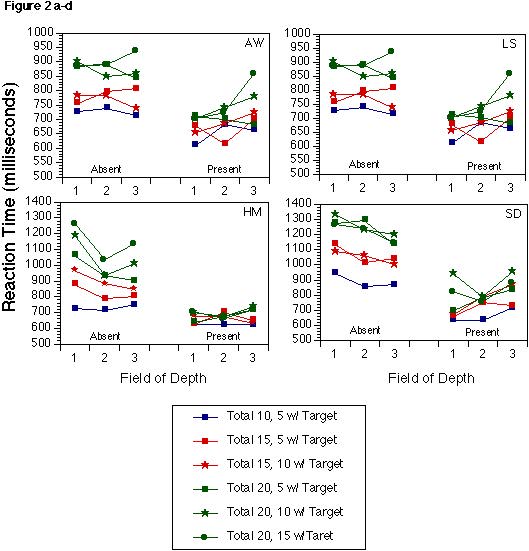
Return to front page.
Problem: Previous research has suggested that stereoscopic disparity may be processed preattentively (e.g. Nakayama & Siverman, 1986; Treisman, 1986), and other research supports the notion of multiple channels to process different disparities (e.g. Julesz and Chang, 1976; Richards, 1970). Given these assumptions, it was hypothesized that searches may be restricted to a particular depth plane. This would allow for more efficient processing because a search occurring in a particular depth plane would not be affected by distractors located at other depth planes.
Method: A series of four experiments was conducted in which subjects performed a search task consisting of looking for an intermediate-sized target among larger and smaller distractors. The first and second experiments tested the serial nature of the search when the target was embedded in the same plane as the distractors, and the preattentive nature of the search when the target was placed in a separate depth plane. The third and fourth experiments investigated the relative influence of the total number of distractors present (regardless of their depth) versus the number of distractors present solely in the depth plane with the target. The three depth placements were as follows: target with some distractors in front of the fixation plane and the remainder in the fixation plane, target with some distractors behind the fixation plane and the others in the fixation plane, and target with some distractors in the fixation plane and the others in front of the fixation plane. In the third experiment, subjects had prior knowledge of the depth plane which would contain the target, while in the fourth experiment target depth plane was randomized.
Results: All trials with incorrect responses were exclude from analysis. For each subject the medians were taken for each condition for each session. A completely within subjects ANOVA was performed for each subject for each experiment.
Generally, results showed a serial search for Experiment 1 and a parallel search for Experiment 2 for all subjects. In Experiment 3 there were several significant main effects and interactions, some of which were not consistent across subjects. For all subjects, target-present trials were responded to significantly faster than absent trials. The pattern of reaction times across depth planes showed no consistency; generally reaction time was better related tothe total number of distractors across all planes. However, this pattern was significantly modified by target presence or absence. For all subjects reaction times in absent trials strongly reflected the total number of distractors while those for the present trials did not. Figure 2a-d shows groupings in absent trials and the collapsing of reaction times for the conditions where the target was present.

The results for Experiment 4, when target depth was not blocked, very closely mirrored those from Experiment 3. As shown in Figure 3a-d, for all subjects reaction times for absent trials were best related to the total number of distractors, while reaction times for target-present trials were collapsed across conditions.

A comparison of the latter two experiments show similar trends. Namely the nonsystematic effect of depth plane and, for the target-absent trials, the reaction time groupings based on total number of distractors. In order to further this comparison, we created graphs (Figures 4a-d) which averaged reaction times across depth planes and which averaged reaction times for conditions which had the same total number of distractors. Further, we placed the results from Experiments 1 and 2 on the same set of axes. These new graphs show response patterns in Experiments 3 and 4 to be similar to those seen in the serial search from Experiment 1. For most subjects it was found that reaction times when distractors were spread across two depths were faster for present trials than those when all distractors were placed in one depth with the target.
Discussion: The results from Experiments 3 and 4 seem to refute the idea that disparity is processed in a purely parallel manner. The current experiment suggests a model in which target-present trials and target-absent trials are searched in different manners when disparity is included. For target-present trials, we theorize that separate depth channels can be accessed in parallel for a quick first search of a display which ends with the detection of the target. This conclusion is further supported by the decrease in reaction times seen when the viewing field was split into two depth planes, possibly by dividing the processing across separate depth channels. When the target is absent, a target will not be detected by this quick first search, causing a reversion back to a purely serial search across the entire display. Since knowledge of target depth has little or no effect on reaction times, we suggest that particular disparity channels are not accessed individually.